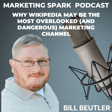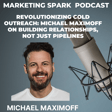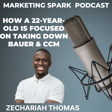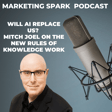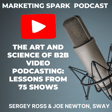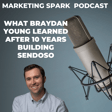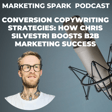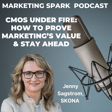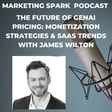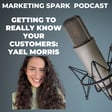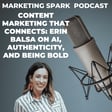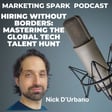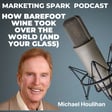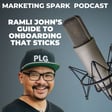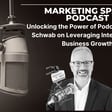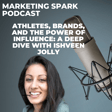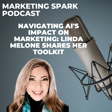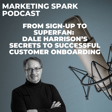Introduction to Marketing Spark Podcast
00:00:03
Speaker
Hey, it's Mark Evans, and you're listening to Marketing Spark.
The Role of LinkedIn in Modern Marketing
00:00:07
Speaker
One of the best things about LinkedIn is how people are willing to respectfully disagree with you. It's a place for constructive criticism and insightful conversations.
Debate: Gated vs Ungated Content for B2B SaaS
00:00:18
Speaker
A few weeks ago, I published a post on the merits of gated versus ungated content and the benefits for B2B SaaS companies looking to drive brand awareness in leads.
00:00:29
Speaker
A comment that caught my attention came from Jonathan Bland from Omni Lab Consulting. He not only offered up his thoughts about data content, but suggested that we connect to discuss it. And so here we are. Welcome to the podcast, Jonathan. Awesome. Thanks for having me.
The Value of Gated Content in Niche Markets
00:00:46
Speaker
So let's dig into ungated versus gated content. From my perspective, I'm on the fence. On one hand, I see the value of gated content by companies operating in a market with a few hundred potential customers. You want to connect with those people. You want to know who they are. On the other hand, I see ungated content as having value for companies looking to drive brand awareness in highly competitive spaces.
The Origins and Evolution of Gated Content
00:01:11
Speaker
Now that's my view of the world.
00:01:14
Speaker
How do you see it? Because I think we're coming from different perspectives. And the reason why I wanna do on the podcast, one of the reasons is that you've got a different take on things. And I'm really curious for us to get into it. So I think we have to back up for a second and actually talk about why people started gating in the first place and why it even exists. And the big reason that people have started gating where we're gating, you know, years ago, 10, 15 years ago,
00:01:39
Speaker
is because there wasn't easy access to third-party data where you could literally just look up with filters and firmographic criteria and say, hey, I need a couple of emails for these people, and I'm going to go after
Shifting from Gated Emails to Third-Party Data
00:01:50
Speaker
them. There weren't data providers like that that were really good. So people needed to capture someone's email address in order to go after and contact them. That, and then fast forward a little bit, and now HubSpot's kind of become the behemoth that it is,
00:02:04
Speaker
and they've been marketing the idea of doing email nurtures and taking in emails and calling them mqls and running them through a waterfall of sending them personalized content etc so in order to feed that beast you need more emails so that that sparks the reason more to have gated content running so that you can again run those plays of which again feeds more into HubSpot's model which of course is to sell you more of
00:02:29
Speaker
the marketing contacts that are in their systems, one of the variables they use for charging you what they charge. So I think that those are two things to keep in mind. I think the
00:02:39
Speaker
The reality of what's happening now though, is that people don't need to pay money and especially the price that they're paying for an email off a gated piece of content. They don't because they can go out and get that same email address from a third party data provider. And frankly, with almost the same intent, because I would argue that on LinkedIn and Facebook, most of those people that are actually downloading your top of funnel content, they don't have a lot of intent.
Maximizing Reach with Ungated Content
00:03:03
Speaker
There's a little bit, certainly there's maybe some interest in the content you're looking at, but these are people that like reading and consuming that content.
00:03:09
Speaker
So so there's a big big issue there that i see the other is that you know kind of talking about why people gate is they need attribution in the channel itself. See look at linkedin and facebook they're low and ten channels people are generally not looking to buy right now they're looking to be educating looking to engage with friends family coworkers whoever.
00:03:30
Speaker
They're not looking necessarily to buy right now. So again, most of the CMOs, most of the VPs of marketing leads that we're working with are running it because they want to make sure that they can hit some type of an MQL number and say that, hey, we can justify the ad spend on LinkedIn and on Facebook and say, hey, the $10,000 that we spent on LinkedIn, that was worth something. Because we got X amount of leads out of it and the cost per lead was X and that meets the unit economics that we were trying to hit earlier.
00:04:00
Speaker
But the issue with all of that that I have is that all of these
00:04:04
Speaker
You know, really, I guess maybe where I should go is where they should be thinking about these channels is using them instead not to capture an email address that has very low intent where they're paying an exorbitant amount of money on. They should instead be opening up that content, getting maximum reach on it, trying to use as much of the content that they're trying to send that person to and get that into the actual ad itself so they can consume it. Because again, you're looking at 1%, maybe higher if you've got a really good engagement on an ad.
00:04:33
Speaker
99% roughly of those people are not going to click and follow through and get off the platform. So making sure that you can get as much of that content in that ad and educate them there so that ultimately in the longer term, as they start seeing more content, whether that's product marketing, events, webinars, content blogs, case studies, all of these things that we can distribute.
00:04:54
Speaker
Ultimately, what you want is have them come back into your cycle when they're actually ready to buy versus throwing them into a funnel and saying, all right, now I have your email.
Is Gated Content Still Relevant Today?
00:05:03
Speaker
Now what I'm going to do is throw you in this linear journey where you're going to first go here, then you're going to go here, and then you're going to go there, which we all know that just doesn't happen. We don't buy that way. I mean, have you ever bought a product where literally they're like, oh, thank God, I got that number three email and got that little piece of content. Now I really want to move forward. It's like, no, that's not what's happening here.
00:05:22
Speaker
So those are, I guess, some of my initial thoughts on it. There's a lot of things to say about gated. Again, not necessarily always a bad idea. And in fact, one thing to say that's a little bit counterintuitive here to what I'm just saying is sometimes we'll actually run gated in order to get data back about what the conversion rates are after you actually collect all those emails. So for early stage companies that are like, oh, they've read the HubSpot playbook, they want to get into it.
00:05:46
Speaker
We're looking at, all right, well, if you haven't run it before, and you're really curious, and you're really just motivated to do this, let's go ahead and run it. But then let's go ahead and look at what the conversion rates are after we've run that campaign. So we'll look at three, six months, and 12 months out of, hey, for the emails that we actually collected from that gated ebook, or that gated piece of content, whatever it may be, how many of those actually convert? And what we see is that a very small amount convert. We're talking 1%. So 1 out of 1,000 are converting off of that ebook.
00:06:15
Speaker
Whereas you can be much more effective when you're actually driving people to a higher intent type of conversion, which is people that are actually raising their hand, want to talk to sales, et cetera, and then get them into a motion there. And you'll obviously see conversion rates a lot different. So anyway, stop there. Those are some of my thoughts, I guess initially.
00:06:31
Speaker
That's a lot of thoughts in one answer. But let's unpack. There's a lot to unpack here. I guess the question that a lot of marketers are asking is whether gated content is dead, whether it no longer makes sense to secure an email because there's not a lot of value there. And as you say, a lot of it has low intent activity.
00:06:57
Speaker
Whether it's better and a friend of mine steve what who's very well known be to be sass marketers suggest that it's better to get it out there to drive as much distribution as you can so that you. Get into the buyers universe they start thinking about you base recognize hey this is really great content and then you can hit them from different sides of the marketing equation.
00:07:22
Speaker
I mean, there are situations, of course, where you do want to experiment with gated content. But for the most part, I think what you're suggesting is that it really isn't a viable marketing tactic anymore, particularly because there's so much ungated content out there. Yeah, I mean, I guess there's there's two things. One, you haven't done it before. So you don't have data on how effective it is. And you're really curious to understand what those conversion rates look like. The other is you're already doing it today. You're doing a ton of gated content.
00:07:50
Speaker
And if your measure of success was generally for those that are doing a lot of gated content, a lot of times the measure of success is in QLs. It's the number of conversions you're getting off of that spend. So for those, we need to be very careful. You don't just pull gated down and say, well, it's just that easy. Let's just ungate everything. I mean, if it was that easy, everyone would have already ungated everything already. The reality though, is you just, again, have to come back to how are marketers being measured, which I talk about a lot on LinkedIn.
00:08:16
Speaker
and the measurement is very critical. And if the measurement today for a VP of marketing is a number of MQLs and an MQL for them is a download, then getting them away from gated immediately would be a bad idea. We need to first initially figure out ways to move away from that in a slower manner so they can still hit some of their short-term goals and then figure out how do we find a new measurement of success for them? Because ultimately the CEO is gonna come back and some point say, hey, where's the pipeline and where's the revenue that we're getting from marketing?
00:08:46
Speaker
while marketing still saying, hey, listen, like, you know, we're measured on leads. That's what you told us to do. So there's constantly this back and forth. So I think those are two little, two little caveats to thinking about just going away from gated completely and when you should do it.
00:08:59
Speaker
You mentioned one of the problems in marketing right now in modern-day marketing is this friction between marketing and the CEO.
CMOs Under Pressure: Navigating CEO Expectations
00:09:10
Speaker
They don't often operate in collaborative partnerships. It's almost like they're opposing forces.
00:09:17
Speaker
And that's one of the reasons why marketers are under the gun and one of the reasons why marketers the tenure of the cmo. Continues to shrink because there's so much pressure on marketers to perform and you're right they do but depend a lot on mqls which as you say are very low intent and they're they're simply an expression of interest more than anything else.
00:09:39
Speaker
Well, I'll just interrupt you for one second just to clarify what I just said there. MQL depends on how you define it though. Right. Depends on how you define it. Someone might define an MQL as a higher intent lead that has actually come in via demo request. So that's also possible. So just want to clarify that for the audience.
00:09:54
Speaker
There were different ways to slice and dice, but a lot of MQLs are just somebody who's at most curious, but marketers need attribution. They need to justify, I'm spending this much money. You're paying me this much money. They need some tangible metrics. I think that's part of the problem right now is that how you measure marketing
00:10:14
Speaker
Is becoming increasingly difficult chris walker talks about the dark web and we're gonna get into it and the fact that attribution is increasingly challenging so as a marketer like what do you do right now in terms of trying to quantify your success.
Holistic Marketing: Performance Over Metrics
00:10:29
Speaker
It comes back to looking things at an aggregate, you've got to get away from the channel and looking at how each channels individually performing and saying, when I go into LinkedIn or Facebook, I don't necessarily need to see a billion leads in LinkedIn and Facebook, what I need to do is I need to look at my overall aggregate marketing engine. And what I want to see is, and this is what we look at across all the B2B SaaS companies work with, we first look at how many high intent leads are we driving to the company high intent leads for us mean people that are coming in
00:10:57
Speaker
looking to talk to sales. That could be Contact Us, it could be a live chat, it could be Dimmer Request. It's the first thing we're looking for. I don't necessarily care what channel they came from. I don't care. My point is, before that, I'm just saying, if I've got an audience that's on LinkedIn, if I've got an audience that's on Facebook, if I've got an audience that's on Reddit, wherever that audience is, I want to make sure that I have messaging in front of them that's not only making them aware of my brand,
00:11:21
Speaker
but educating on them how we can help solve a problem, pain or a want or desire, something that they are looking for. And I want to make sure I have that message in front of them. So first of all, we're literally looking at that from the aggregate, right? And then we're saying, all right, overall, are we driving more marketing source pipeline to the business and marketing source pipeline for me is again, you know, you're tagging that person that came in as looking to talk to sales. Did that person ultimately convert to pipeline?
00:11:47
Speaker
And we're seeing conversion rates when you look at this upwards of 30 to 65% on lead to opportunity when you classify it as a high intent lead, someone coming into wanting to talk to sales. And then the last is, of course, marketing source revenue. So really those are the three and then there's some tertiary things around it like ACV growth, sales cycle decreasing.
00:12:06
Speaker
was our CAC payback look like, things of that nature to make sure that we're obviously justifying what's going on. But that's what we're looking for. I have these conversations all the time. And frankly, just the other day talking about it, and everyone's panicking like, oh my god, we're the leads out of LinkedIn, we're the leads, and we're not gating any content. We get very little leads off of LinkedIn directly attributed. If you go into the channel, it would look like it's a train wreck.
00:12:28
Speaker
We're spending thousands of dollars where the leads. However, we know that our audience is there. We know that the engagement is very high, right? We can see that time on page, bounce rates low, CTR is very high. We know there's a good engagement with the content. We know that as we continue to spend more money, we're starting to drive more high-end demos to the brand.
00:12:48
Speaker
So these are the things that at least that I look at, I, again, tried to keep things very simple. I think marketing has gotten so complex, we're always constantly creating new acronyms, it's none of it's necessary. We just really need to kind of bring it back to the basics and realize like, ultimately, what are the numbers we're trying to move forward. And by the way, those numbers are the same as sales, right? I mean, sales were aligned with the same pipeline number. And yes, I do like to split the funnel and understand, hey, what does marketing bring versus sales, because ultimately, marketing should bring the lion's share of the pipeline to sales.
00:13:18
Speaker
Overall, I want to see that trend. That's another thing we look at as well. What is the percent of marketing source pipeline that we're bringing as it compares to the whole? So stop myself there. But those are a couple of things I look at and they'll get too lost in looking channel by channel.
00:13:31
Speaker
I love the idea of simplicity versus complexity and the fact that we often lose sight of the fundamentals because as marketers we're fascinated with metrics, KPIs and all the tools at our disposal. One of the biggest challenges for marketers these days is attribution and we've touched upon it a little earlier and the fact that it is increasingly difficult to correlate
00:13:55
Speaker
what you do to end results and there's this whole notion of the dark web and it's things that we have known before like we have known for example that prospect is seventy percent down the pipeline according to gartner before they even touch a company before they even contact the company so they've already done their due diligence and research.
00:14:14
Speaker
And that's a different type of relationship. There's a lot of recommendations going on, people checking out G2 and Captera, people sourcing, as you say, looking at content on LinkedIn. So there's all this marketing activity going on and consumption going on. And we don't see any
Exploring the Dark Web in Marketing Strategies
00:14:31
Speaker
of it. So as a marketer trying to justify
00:14:35
Speaker
what you're doing tactically and strategically and trying to say to your boss, listen, we're doing a good job. How do you deal with the dark web? How do you recognize that there's a lot going on and how do you get any kind of insight into it so you can adjust what you're doing from a strategic and tactical perspective?
00:14:53
Speaker
Yeah, it's a great question. I think the first thing you need to do is before you start investing heavily in these dark web areas, these are communities, podcasts, you name it. I mean, all of these different things that all these different places that you can be before you do that, you need to be able to hit your short term goals before you can even get the support to actually go after some of those longer term initiatives.
00:15:12
Speaker
Podcast isn't something that you're just going to start in a month later, all of a sudden leads are raining in. You can't set the expectations with your CEO like that. So first of all, it's meeting initial pipeline goals. And those can be done, by the way.
00:15:25
Speaker
without making large investments in the dark web before. Um, but as you, as you get past that, and as you start, you know, to be able to hit some of those initial goals on the short-term perspective, then it's about saying, all right, which of those channels do we really feel like are worth investing more time in? And you guys have to pick, right? I mean, especially if you're an early stage company, you can't be on all channels doing all things. But again, with a very small team, you should be able to do a very good job of at least doing a kind of baseline podcast, getting some organic content out on LinkedIn.
00:15:53
Speaker
getting a little bit more active in some communities where your audience is hanging out. And then on the attribution front, the way that you think about it there is you can put, number one, a forum on your website that just says, how did you hear about us and make it require it? That's one way. You can hear about it in the sales calls when you're recording with hopefully gong or course or whatever tool you use to record those calls. You can hear what people are saying and how they're hearing about it and train your sales reps to ask. You can see it in the engagement and the likes and the comments and what people are saying.
00:16:22
Speaker
so that you can say, hey, is this content actually resonating? Are people actually engaged with this? In fact, I mean, it's one of the ways that honestly, OmniLab has grown to where it is, we don't do any outbound at all. We do, I mean, literally everything that we do is just through LinkedIn.
00:16:35
Speaker
And it's just writing content and trying to be helpful, educate people, connect with the audience, et cetera. And that's it. And the way that I judge success is I hear people talk about it. And when they call me up and they say, you know, I don't even have to ask how did I hear about it, they say, oh my God, I love your content. Like the post that you had the other day said, blah, blah, blah, blah, it was really interesting. It made me think about this XYZ or, hey, we really align on what you just said there.
00:16:56
Speaker
And those are my signals to be able to say I know this is working right because I'm getting the qualitative signals. Maybe I don't have it in a nice perfect report. LinkedIn hasn't spit out an organic report that said you got X amount of leads and that generated this amount of pipeline and revenue. But I know and I just know because I'm hearing it. I feel it. So when it's working and it's going well.
00:17:16
Speaker
You're not going to need data. You're not going to need data in the form of a quantitative attribution report to say it's tied to the specific account is what I mean. Businesses like ours and we're arguably boutique businesses. I think we're living and breathing the power of LinkedIn every day. Like you, I produce a lot of content. A lot of the leads that I get, and I do get a lot of leads from LinkedIn, are people who have never engaged with me. I never see their comments.
00:17:40
Speaker
I never see their likes, they're invisible, like they are dark. The fact of the matter is it's almost like a test, like a laboratory for what kind of marketing works these days and the fact that people are reading content and they are looking at comments and after a while it starts to resonate and you become a resource that they trust. And I think that's really, really interesting. One of the things that I'm curious about is when you're
00:18:07
Speaker
fast-growing company and you look at the marketing mix, as you say, you can't be all things to all people. You cannot be everywhere. Given what's happening in the dark web, given what you can and can't attribute, how do you create the right marketing mix? How do you know that you're actually doing the right things at the right time?
00:18:28
Speaker
within the dark web specifically you're talking about. Overall, including the dark web, because some of the stuff you can see, you can see if I do this, this happens, and some of it you can't see. So how do you know you're putting, you're pulling the right levers? Well, I mean, the basic mix, I mean, in terms of like what we see across all the different companies we work with is, you know, it's a combination of usually search LinkedIn, Facebook, a podcast,
00:18:52
Speaker
and organic content on usually LinkedIn, sometimes other platforms. But typically, that's the mix, right? Initially, when we start working with a lot of these brands, and even some today, honestly, a lot of them have probably 70 to 80% of their budget on search.
00:19:09
Speaker
They're all thinking about how do we capture right now and convert those people into leads. And while search is a very important channel, I was actually just talking about this today, the point is that you need to start leveraging more and getting ahead of the demand, being the person where they're actually figuring out and finding your brand, which is in social channels, which is in communities, which is talking to friends and doing those other things.
00:19:31
Speaker
and reallocating your budget. So immediately what I think about, and this is not a hard rule, but I'm really looking at 40% to 50% of the budget potentially on search, the other half across dark web channels, the other half around paid social, anything related to social media, because that's, again, where people are figuring out about your brand, where they're finding, hearing about who you are, what you do, what you can offer from whether it's a product marketing perspective, events, I mean, you name it, whatever type of content you want to throw across it.
00:20:01
Speaker
So I think that's initially the mix that we're typically deploying and the way that I think about it. But ultimately it comes back to, are we hitting our initial short-term goals on some of the key channels where we can potentially track things a little bit better because a lot of people are nervous at first if you're in that position?
00:20:16
Speaker
Others, you're potentially a lot more calm and centered and you know that you understand marketing, you understand that these things do take time and you're not going to be able to attribute everything. And for those companies, some of the ones that we talked to, they're a blank slate, which is great. We can build out a whole new plan for them and get them immediately engaged where their audience is, whether that's organically on a podcast, you name it, et cetera. But again,
00:20:39
Speaker
It just comes back to figuring out how many resources do I have to pull out, push out some great content. And again, the great thing about a podcast is that you've got the video, you've got the audio, you can repurpose it, you can subtitle it, you can put it out into blog posts, et cetera. So it's extremely versatile in terms of what you can do with a podcast to really stretch that content. So you think about the investment in a podcast is not really massive for people if you think about just that one piece of content. So that's generally how we think about it.
00:21:08
Speaker
Let's talk tactical execution and I'm glad you mentioned the idea of a podcast because with many of my clients, I'm an advocate for podcasting.
The Power of Podcasting in Marketing
00:21:17
Speaker
I jumped on the bandwagon just over a year ago and the benefits have been, there's so many benefits to podcasting. James Carborio, Sweetfish Media suggests that it won't be long before every B2B SaaS company needs a podcast just like every B2B SaaS company has a blog.
00:21:36
Speaker
Is that the reality that you're seeing? Is podcasting so attractive that it's a no-brainer to launch one?
00:21:43
Speaker
No, I'm not seeing that at all actually. I'm still seeing a very small few that have really dove into building out a podcast. And frankly, what I actually see more of is let's build a podcast to see if we can get a bunch of leads and then say the sixth, 10th, 12th episode, they shut the whole thing down because it didn't generate anything. Right.
00:22:07
Speaker
So typically, that's what I'm saying. I'm not saying that there's consistency in staying with it. There's people that want to try it out, but there's so much expectation around making sure that podcast is actually delivering on leads. And the thing about it is, again, podcasts are very, very hard to attribute. There are certainly little ways that you can do it. But at the end of the day, people are hearing your podcast. They may not be participating. They may have gotten the recorded version. They may have got the repurposed thing. They didn't click.
00:22:33
Speaker
so many different holes and being able to track that. But again, you know, no, I'm not seeing a whole lot of B2B SaaS companies that are diving in deep to podcasting. If they do again, they stop after a few months.
00:22:44
Speaker
Yeah, it is interesting because I have a client who I convinced to get into podcasting. And there have been times when the CEO says, where are the leads? How many downloads am I getting? And my argument is that there are lots of benefits to doing that. It is conversations that people are listening to. There's lots of ways that you can repurpose podcast content.
00:23:06
Speaker
and really connect with prospects and customers. So I'm obviously a big advocate. The other thing I wanted to ask you about is the benefits of advertising beyond clicks because we spend a lot of money as B2B marketers on advertising and often there's
Beyond Clicks: The Real Value of Ad Content
00:23:22
Speaker
the correlation. If I advertise this much, I'm going to get this many clicks to lead to this many leads in sales. But that's not always the way it works and maybe you can talk a little bit about that.
00:23:31
Speaker
Yeah, 100%. Exactly. I mean, it's like I said before, you've got 99% of people that are generally not clicking on your ad. So what are they doing? They're the ones that are scrolling past it, not clicking either the content wasn't engaging enough, or some other reason that just didn't prompt them to actually click because it wasn't making a connection.
00:23:48
Speaker
But the point is that what you need to do is make sure that you're actually, and this is where I said this a little bit earlier, but make sure that what you're putting in your ad is designed so that it can be consumed almost in its entirety, or at least the bulk of the message you want to get across in the actual ad copy itself, in the creative.
00:24:04
Speaker
Make sure that they can get in, consume it, and stay within the platform. Most people want to stay in the platform. They're scrolling through, they're engaging with people, they're talking to people, they're reading about who said what, so they don't want to leave necessarily all the time to go off to a landing page and then go read more about the company and convert.
00:24:19
Speaker
So it's really important that everything at least that we do in creative is really important to make sure that number one we're getting most of the message out in the copy and in the creative so that it can consume there so we don't have to get the click. We're getting people that are actually being pressed upon by the content and then over time we're getting them going back into.
00:24:39
Speaker
you know going back into our bucket and saying like hey yeah i would actually like to talk to sales when they're ready and we're seeing that too in the forms so for for we've implemented across a lot of different companies but. You know people are saying how to hear about us are saying linked and they're saying social media things of that nature some variations obviously it's data is never perfect but we're seeing that and so we know that there's definitely a whole lot going on past the click so sometimes you can't put it in perfect marketing math right to your point where you say.
00:25:06
Speaker
OK, this many clicks, this many visits, this many current versions of the website, so on and so forth. It just isn't that easy.
Educating Prospects for Intent-Driven Engagement
00:25:13
Speaker
The other area that I want to touch upon is demos. I recently had somebody on who is all about demos. And it is the holy grail for a lot of B2B SaaS companies. I mean, you can frame it, talk to an expert, learn more. But ultimately, what you want is conversations. You want people to ask for a demo request. Because as you said earlier, it's high intent.
00:25:34
Speaker
So the question is, as a B2B SaaS company, how do you drive demos? How do you get people to actually want to talk to your salespeople? Because there's a lot of reticence out there because no one wants to be oversold, but they do want to learn. So what are best practices when it comes to driving demos?
00:25:50
Speaker
Honestly, you want to do so much marketing actually on the front end that they don't even really need to be sold. So when they ultimately get to talking with an AE, they've already been so educated and you've removed the barriers from a friction standpoint. You've got transparent pricing.
00:26:06
Speaker
You've got easy content that's not gated that's easily accessible. You've got product little short clip product videos that speak to the story and the problem that your clients have. You've got easy to understand language on your website that isn't technical or filled with jargon and acronyms. It's outcome based. It's written very simply with the fewest words possible. And when you do all these things
00:26:27
Speaker
Right overtime you make it so easy for the person understand what you do that they come in and they already are pretty much sold on going with you that the sales rep really is there to maybe just ask a few little questions make sure that they're qualified what not and then move them through there already ready to go so i think that honestly what i'm saying is that,
00:26:46
Speaker
There's gonna be a transition at some point where the sales person is really honestly starting to change me for a company is really doing awesome marketing. The sales person almost turns into more of like customer success manager or someone that's really just there to kinda be a lending hand and kinda bring them through to the rest of the deal. So that that's honestly like i mean if marketing is being really well and i guess getting into some of the tactics around that again it's kind of like some of the things i was just saying there i mean getting.
00:27:09
Speaker
getting transparent pricing, ungated content, opening up product videos. A lot of companies hide their product. They don't want to put it out there. They think if they put out their demo video that they're not going to decrease leads. And a lot of times they do, but they ultimately educate people more and let them either qualify themselves out and learn more about the product. Sixth Sense is a great example of this. They have great product videos that are very educational.
00:27:36
Speaker
They're not just about the product itself, but they're outcome driven and they help you understand what it does and what it is. And I think if a lot more companies took that to heart and not worried about gating everything and putting lead forms behind everything and making it more difficult for the person to buy, you would have a whole lot more people coming through and that sales cycle would be a lot shorter.
00:27:55
Speaker
Yeah. And ultimately you want to reduce friction. I mean, the harder you make it for people to learn about your company, the more difficult you make it for people to understand what you do and the benefits and ultimately what's in it for them. The more cautious they're going to be in, the more likely is that they'll go to somebody else. And I think that's one of the things that we have to think about as marketers is we want to make it as simple and as easy to engage with us and ultimately to buy from us.
00:28:19
Speaker
People will always choose the least passive resistance, always. So if you're making it harder, then they're going to be going to your competitor, as you said. That's just the way it's going to work. They're going to go wherever it's easier to buy. And if you make it hard for them, and if you hide information, put walls up, you're only shooting yourself in the foot. I think that's a great way to wrap
Connecting with Jonathan Bland and OmniLab
00:28:41
Speaker
things up. And thanks for all the great insight, Jonathan. Where can people learn more about you and OmniLab?
00:28:46
Speaker
Yeah, so the easiest place is find me on LinkedIn, just Jonathan Bland, OmniLab, that should be able to find me. Or you can go to our website, just omnilabconsulting.com and read a little bit more about us there. But generally, I'm pretty active on LinkedIn. So yeah, shoot me a message or reach out if you guys have questions. And in a snapshot, maybe you can tell people what OmniLab does.
00:29:06
Speaker
Yeah, so the core of it, we're a demand gen B2B SaaS agency. So we predominantly work with seed to series B stage companies. We run paid media for them. So we're really, first of all, kind of aligning with number one, their pipeline and revenue goals. It's a big thing that we do, make sure that we're understanding what's actually happening within their CRM and optimizing ad channels accordingly.
00:29:28
Speaker
Typically it's Facebook, LinkedIn, search, really the gamut from a paid social perspective. And then obviously we do a whole lot of creative analytics work as well to kind of wrap everything together. But again, biggest thing for us that I can, I can't harp on enough is, you know, we're not a lead gen type of agency or an agency that ultimately is aligned with whatever the goal is that marketing has, which typically for us is people that are aligned with pipeline and revenue so that we can focus on driving high intent inbound demand requests through to the company.
Conclusion and Call to Action from Mark Evans
00:29:56
Speaker
Thanks for listening to another episode of Marketing Spark. If you enjoyed the conversation, leave a review, subscribe via iTunes, Spotify, or your favorite podcast app, and of course, share via social media. To learn more about how I help B2B SaaS companies as a fractional CMO, strategic advisor and coach, send an email to mark at marketingspark.co or connect with me on LinkedIn. I'll talk to you next time.
![To Gate or Ungate Content, That is the [Marketing] Question image](https://media.zencastr.com/cdn-cgi/image/width=54,quality=85/image-files/5eea42464e4bd10063e7c0f8/b016fe02-5421-477b-bd7b-dbf5afaa8ab0.jpg)
